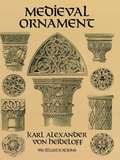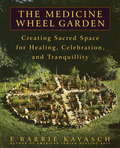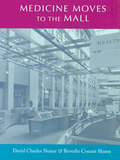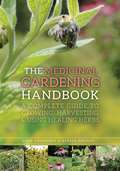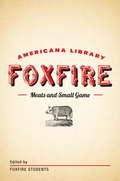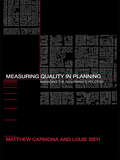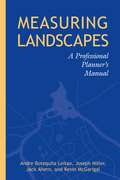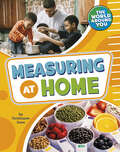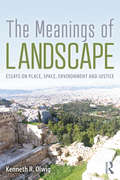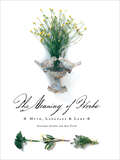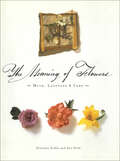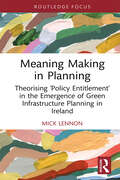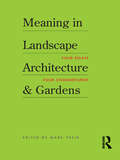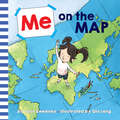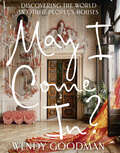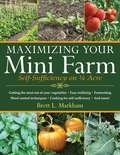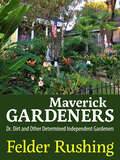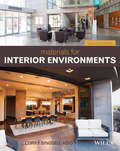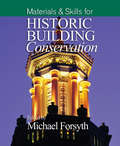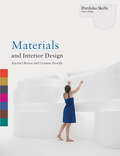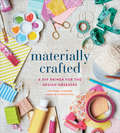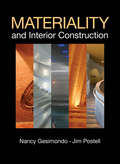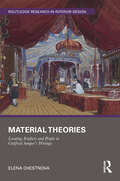- Table View
- List View
Medieval Ornament: 950 Illustrations (Dover Pictorial Archive)
by Karl Alexander HeideloffThe decorative arts of the Middle Ages -- richly ornate, filled with religious and mythic symbolism -- were especially remarkable for the complexities of their design and their inspired craftsmanship. This fascinating volume presents nearly 1,000 illustrations of medieval ornament, consisting mostly of architectural elements from German Romanesque and Gothic churches and other buildings.Originally compiled by the German architect, painter, and engraver Karl Alexander von Heldeloff (1788-1865) as a source of study and inspiration for practicing artists and architects, this grand pictorial archive has been exactingly reproduced from a rare original edition, complete with new English translations of the German captions.The book is filled with precisely detailed engravings of doors, windows, decorative stonework, columns, pedestals, and more. It remains a richly varied resource of authentic images of medieval ornament, ideal for students of architecture and the decorative arts and essential for graphic artists and designers in search of royalty-free illustrations.
The Medicine Wheel Garden: Creating Sacred Space for Healing, Celebration, and Tranquillity
by E. Barrie KavaschThe American Indian medicine wheel was an ancient way of creating sacred space and calling forth the healing energies of nature. Now, drawing on a lifetime of study with native healers, herbalist and ethnobotanist E. Barrie Kavasch offers a step-by-step guide to bringing this beautiful tradition into your own life--from vibrantly colorful outdoor circle designs to miniature dish, windowsill, or home altar adaptations. Inside you’ll find: • Planting guides for medicine wheel gardens in every zone, from desert Southwest to northern woodlands • A beautifully illustrated encyclopedia of 50 key healing herbs, including propagation needs, traditional and modern uses, and cautions • Easy-to-follow herbal recipes, from teas and tonics to skin creams and soaps--plus delicious healing foods • Ideas for herbal crafts and ceremonial objects, including smudge sticks, wind horses, prayer ties, and spirit shields • Seasonal rituals, offerings, and meditations to bless and empower your garden and your friends, and much more Practical, beautiful, and inspiring,The Medicine Wheel Gardenleads us on a powerful journey to rediscovering the sacred in everyday life as we cultivate our gardens . . . and our souls. From the Trade Paperback edition.
Medicine Moves to the Mall (Center Books on Space, Place, and Time)
by David Charles Sloane Beverlie Conant SloaneThe shopping mall seems an unlikely place to go for health care services. Yet, the mall has become home to such services as well as a model for redesigning other health care facilities. In Medicine Moves to the Mall, David Charles Sloane and Beverlie Conant Sloane document the historical changes to our health care landscape by exploring the interactions between medicine and place. This unique combination of architectural history and the history of medicine provides a thought-provoking analysis of the geography of the practice of medicine.The book presents three essays, each accompanied by a gallery of historical and recent photos. The authors discuss the rise of modern hospitals and how they were shaped into scientifically sterile and humanly stark "medical workshops." Starting in the 1970s, hospital facilities were altered in appearance to become more friendly and welcoming. The integration of a shopping mall's spaciousness and open design with technology and scientific innovation served in "humanizing the hospital." Most recently, the accessibility and convenience of shopping center and roadside clinics have invited Americans to go "shopping for health" in the increasingly commercialized medical system.Medicine Moves to the Mall will appeal to scholars and professionals in fields ranging from health care to cultural geography and from urban studies to architectural history, as well as to readers interested in the shifting status of medicine in American society.
The Medicinal Gardening Handbook: A Complete Guide to Growing, Harvesting, and Using Healing Herbs
by Dede Cummings Barbara Fahs Alyssa HolmesDig into the world of herbal medicine with this complete guide to cultivating and harvesting plants with healing properties. For thousands of years people have been utilizing herbs and cultivating weeds found to speed the healing of wounds, soothe skin irritations, calm uneasy stomachs, and ward off illnesses. Now you can plan and grow your own garden first aid kit.In these pages, you'll learn the basics of gardening in your backyard-or on your windowsill or porch-including instructions for preparing soil, composting, and weeding. You'll then find detailed descriptions of the twelve most common, easy-to-grow, most useful healing herbs, with instructions for growing, harvesting, and utilizing them. These powerful plants include: Garlic, which boosts immunity, reduces blood pressure, and combats cancer Echinacea, which reduces inflammation, boosts immunity, and has antiviral properties Yarrow, which accelerates the healing of wounds, is an anti-inflammatory, and can relieve PMS symptoms Elderflower, which is an astringent and can relieve arthritis and soothe sore throats Mint, which soothes digestive problems, sweetens breath, and can reduce fevers Elecampane, a respiratory tonic with antibacterial and antifungal properties And more!
Medical and Dental Space Planning: A Comprehensive Guide to Design, Equipment, and Clinical Procedures
by Jain MalkinTHE UPDATED DEFINITIVE REFERENCE ON MEDICAL AND DENTAL OFFICE DESIGN Medical and Dental Space Planning is an indispensable guide to the myriad of details that make a medical or dental practice efficient and productive. The unique needs of more than thirty specialties, as well as primary care, are explained in the context of new technology and the many regulatory and compliance issues influencing design. Concepts are also presented for ambulatory surgical centers, diagnostic imaging, clinical laboratories, breast care clinics, endoscopy centers, community health centers, radiation oncology, and single-specialty and multispecialty group practices and clinics. A thorough review of the latest dental technology and many creative space plans and design ideas for each dental specialty will be of interest to both dentists and design professionals. Important topics like infection control are top of mind, influencing every aspect of dental office design. An "inside look" at what goes on in each specialist's office will familiarize readers with medical and dental procedures, how they are executed, and the types of equipment used. Technology has radically impacted medical and dental practice: digital radiography, electronic health records, mobile health devices, point-of-care diagnostic testing, digital diagnostic instrumentation, CAD/CAM systems for digital dental impressions and milling of restorations in the dentist's office, portable handheld X-ray, and 3D cone beam computed tomography for dentists all have major implications for facility design. The influence of the Affordable Care Act is transforming primary care from volume-based to value-based, which has an impact on the design of facilities, resulting in team collaboration spaces, larger consultative examination/assessment rooms, and accommodation for multidisciplinary practitioners who proactively manage patient care, often in a patient-centered medical home context. The wealth of information in this book is organized to make it easy to use and practical. Program tables accompany each medical and dental specialty to help the designer compute the number and sizes of required rooms and total square footage for each practice. This handy reference can be used during interviews for a "reality check" on a client's program or during space planning. Other features, for example, help untangle the web of compliance and code issues governing office-based surgery. Illustrated with more than 600 photographs and drawings, Medical and Dental Space Planning is an essential tool for interior designers and architects as well as dentists, physicians, and practice management consultants.
Meats and Small Game: The Foxfire Americana Library (4) (The Foxfire Americana Library)
by Inc. Foxfire FundGreat for hunters, fishermen, and adventurous cooks, this illustrated entry in the Foxfire Americana Library shares a wealth of information from Appalachian experts on how to dress and cook meats and small game, including fish, hog, raccoon, rabbit, squirrel, turtle, and deer.
Measuring Quality in Planning: Managing the Performance Process
by Matthew Carmona Louie SiehThis book deals with one of the current major debates in planning: how to measure the quality and effectiveness of the output of the planning process. It deals with issues of defining quality, public sector management, the use of indicators and the planning process. Although case study material is drawn from UK practice this topic is universal and the authors include discussions of international practice and experience.
Measuring Landscapes: A Planner's Handbook
by Jack Ahern Joseph Miller Kevin Mcgarigal Andre Botequilha LeitaoThis practical handbook bridges the gap between those scientists who study landscapes and the planners and conservationists who must then decide how best to preserve and build environmentally-sound habitats. Until now, only a small portion of the relevant science has influenced the decision-making arenas where the future of our landscapes is debated and decided. The authors explain specific tools and concepts to measure a landscape's structure, form, and change over time. Metrics studied include patch richness, class area proportion, patch number and density, mean patch size, shape, radius of gyration, contagion, edge contrast, nearest neighbor distance, and proximity. These measures will help planners and conservationists make better land use decisions for the future.
Measuring at Home (The World Around You)
by Christianne JonesYour house is packed with big things and small things and everything in-between. How tall is your refrigerator? How long is your bed? How wide is your door? Colorful photographs and interactive, rhyming text will have early learners ready to measure after reading this picture book.
The Meanings of Landscape: Essays on Place, Space, Environment and Justice
by Kenneth R. OlwigCompiling eighteen authoritative essays spanning an extensive academic career, author Kenneth R. Olwig presents explorations in landscape geography and architecture from an environmental humanities perspective. With influences from art, literature, theatre staging, architecture, and garden design, landscape has come to be viewed as a form of spatial scenery, but this reading captures only a narrow representation of landscape meaning today. This book positions landscape as a concept shaped through the centuries, evolving from place to place to provide nuanced interpretations of landscape meaning. The essays are woven together to gather an international approach to understanding the past and present importance of landscape as place and polity, as designed space, as nature, and as an influential factor in the shaping of ideas in a just social and physical environment. Aimed at students, scholars, and researchers in landscape and beyond, this illustrated volume traces the idea of landscape from the ancient polis and theatre through to the present day.
The Meaning of Herbs: Myth, Language & Lore
by Ann Field Gretchen Scoble"Take borage for courage. Send a bouquet of yarrow to declare war. Hang a sprig of rue at the door to keep witches at bay." Like flowers, herbs are steeped in myth and magic, secrets and lore. For centuries, their powers have been called upon to seduce lovers and dispel witches, send hidden messages and brew potent elixirs, entice the palate and soothe the mind. Illustrated with enchanting collages by acclaimed artist Ann Field, this delightful tribute to the meaning and magic of herbs offers a contemporary introduction to an age-old tradition. The text draws on botanical, mythological, and historical sources worldwide, from ancient Rome to Victorian England, from Asia to the Americas, presenting profiles of over 50 herbs favored through the ages. Blending fact, folktale, natural history, and original art, The Meaning of Herbs explores the language and lore of nature's most versatile and powerful gifts.
The Meaning of Flowers: Myth, Language & Lore
by Ann Field Gretchen ScobleShould you send a rose of crimson or of white to the one you love? What gift of flowers best expresses thanks to a dear friend? From ancient days, long before words complicated what we say to one another, flowers have been our messengers, invested with our most cherished feelings. Illustrated with luscious collages by acclaimed artist Ann Field, this enchanting tribute to the power and symbolism of flowers offers a contemporary introduction to an age-old tradition. The text draws on botanical, historical, and mythological sources worldwide, from ancient Rome to Victorian England, from Asia to the Americas, presenting portraits of almost 50 blossoms favored for all time. In Persia, for instance, the black medulla of the red tulip was said to represent the lover's heart, burnt to a coal by love's passion. To Victorians, lavender signified a broken trust, hollyhocks fertility, and nasturtiums a jest or whimsy. Blending fact, folktale, natural history, and original art, The Meaning of Flowers explores the language and lore of nature's most intimate and beautiful gifts.
Meaning Making in Planning: Theorising ‘Policy Entitlement’ in the Emergence of Green Infrastructure Planning in Ireland
by Mick LennonPlanning theorists normally focus on issues of contest and critique. The field of planning theory is thereby replete with studies of conflict, collaboration and criticism. Considerably less critical attention is afforded to policy approaches that emerge, evolve and are widely adopted in the apparent absence of discord. This book addresses this knowledge gap. A case study of the emergence of green infrastructure policy in Ireland is used to both inform and illustrate a theory of ‘Policy Entitlement’. This interpretive approach focuses on meaning making in context to explain the counter-intuitive processes through which a new policy concept can emerge and reprofile planning activities by producing the seemingly pre-existing objective reality to which such policy is then applied and the discipline (re)orientated. This approach accounts for how a new planning concept can appear to resolve problematic policy ambiguity by suspending disagreement on issues where dispute could be expected. This book will be of interest to those studying planning theory and the policy process, as well as those concerned with the undertheorized but swift rise to prominence of green infrastructure planning.
Meaning in Landscape Architecture and Gardens
by Laurie Olin Marc Treib Susan Herrington Jane GilletteWhile we all live our lives in designed landscapes of various types, only on occasion do we consider what these landscapes mean to us and how they have acquired that significance. Can a landscape architect or garden designer really imbue new settings with meaning, or does meaning evolve over time, created by those who perceive and use these landscapes? What role does the selection and arrangement of plants and hard materials play in this process and just where does the passage of time enter into the equation? These questions collectively provide the core material for Meaning in Landscape Architecture and Gardens, a compendium of four landmark essays written over a period of twenty years by leading scholars in the field of landscape architecture. New commentaries by the authors accompany each of the essays and reflect on the thinking behind them as well as the evolution of the author’s thoughts since their original publication. Although the central theme of these writings is landscape architecture broadly taken, the principal subject of several essays and commentaries is the garden, a subject historically plentiful in allusions and metaphors. As a whole Meaning in Landscape Architecture and Gardens offers the general reader as well as the professional a rich source of ideas about the designed landscape and the ways by which we perceive, consider, react, and dwell within them – and what they mean to us. The essays have been perennial favorites in landscape courses since their original publication in Landscape Journal. Bringing them together – bolstered by the new commentaries – creates a book valuable to all those creating gardens and landscapes, as well as those teaching and studying these subjects.
Me on the Map (Me. . Books! Ser.)
by Joan SweeneyMaps can show you where you are anywhere in the world! A beloved bestseller that helps children discover their place on the planet, now refreshed with new art from Qin Leng. Where are you? Where is your room? Where is your home? Where is your town? This playful introduction to maps shows children how easy it is to find where they live and how they fit in to the larger world. Filled with fun and adorable new illustrations by Qin Leng, this repackage of Me on the Map will show readers how easy it is to find the places they know and love with help from a map.
May I Come In?: Discovering the World in Other People's Houses
by Wendy GoodmanNew York magazine&’s interiors editor shares some of her most memorable house profiles in this stunning and inspiring visual tour. For May I Come In?, design editor extraordinaire Wendy Goodman visits seventy homes that express their owners&’ spirit and passions. In this pantheon, imagination and originality hold sway: Artists and eccentrics are the equals of aristocrats and the mandarins of design. Alba Clemente&’s closet is a Renaissance theater; Amy Sedaris built a playroom (but not for children); Andrew Solomon houses his guests in an igloo; Richard Avedon&’s private walls were bulletin boards; Kathy Ruttenberg&’s house is an animal kingdom; Jay Maisel called a former bank with seventy-two rooms home. Every room has a story to tell and a purpose for being. A self-described design hunter, Goodman spent thirty years seeking extraordinary living spaces. In her long career, she has found three things to be true. The first is that curiosity and never giving up will get you everywhere. The second is what Diana Vreeland stated best when she wrote, &“Few things are more fascinating than the opportunity to see how other people live during private hours.&” The third is that houses never lie. These principles underscore her search for individuality, human interest, and authenticity in design.May I Come In? is profusely illustrated with superb images by leading interior photographers, as well as Goodman&’s own snapshots and memorabilia related to her quests. It is an irresistible visual record of the art of living by one of its most astute observers.&“Page after page reveals interiors that practically vibrate with charisma, while others wax a poetic minimalism that, despite a lack of things, overwhelm with grace.&” —Vogue &“When it comes to the New York design scene, Wendy Goodman is positively an institution.&” —Town & Country
Maximizing Your Mini Farm: Self-Sufficiency on 1/4 Acre
by Brett L. MarkhamMini farming describes a holistic approach to small-area farming that will show you how to produce 85 percent of an average family's food on just a quarter acre-and earn $10,000 in cash annually while spending less than half the time that an ordinary job would require. Now expanding exponentially on his bestselling Mini Farming: Self-Sufficiency on ¼ Acre, Brett Markham gives you tips, tricks, and planning advice on how to make the most of your mini farm. New topics include: -Soil and Fertility yy Tools and Techniques-Planting Guides and Seeders-Easy Trellising -Weed Control Techniques-Greater Food Self-Sufficiency-Making Your Own Country Wines-Making Your Own Vinegars -Making Cheese at Home-Cooking for Self-Sufficiency Keep your costs down and production high with this complete guide to maximizing your mini farm-whether it's a rooftop urban garden, a suburban backyard, or a more substantial plot of land. Materials, tools, and techniques are detailed with tables, diagrams, and 200 color illustrations and author photographs.
Maverick Gardeners: Dr. Dirt and Other Determined Independent Gardeners
by Felder Rushing“Be forewarned that this book honors people like the woman in my hometown who paints the numbers of her favorite NASCAR drivers on her elephant ears, and a Tokyo gardener with over a hundred bonsai plants.” So says renowned garden journalist Felder Rushing in his new book Maverick Gardeners: Dr. Dirt and Other Determined Independent Gardeners. In this book, Felder delves deeply into the psychology of what motivates and sustains the Keepers of the Garden Flame. For thousands of years, a loosely connected web of unique, nontraditional gardeners has bonded people across race, culture, language, and other social conventions through sharing unique plants and stories. Found in nearly every neighborhood worldwide, these “determined independent gardeners” (DIGrs) are typically nonjoiners who garden simply and exuberantly, eschewing customary horticultural standards in their amateur pursuits of personal bliss. Included in Maverick Gardeners are classic “passalong plant” lists, a dollop of how-to, numerous color photographs, and thought-provoking essays on quintessential tools, sharing with others, getting away with wildflowers in suburbia, and organizing a plant swap. The centerpiece of this unique gardening journey is the no-holds-barred story of a ten-year cross-cultural collaboration between the horticulturist author and a flamboyant rebellious gardener who called himself Dirt. Through swapping plants and garden lore—and rubbing shoulders with fellow DIGrs—they unraveled their shared humanity. From the practical to the inspiring, Maverick Gardeners is the perfect book for those nonconformist souls who see no sense in trying to fit in and follow the footpaths of others.
Materials for Interior Environments
by Corky BinggeliOrganized by types of materials and applications, this guide helps designers successfully address material evaluation and selection of interior components. Engagingly written, highly detailed, and helpfully illustrated with more than 550 color illustrations, Materials for Interior Environments is a comprehensive guide to everything a designer needs to know about the materials available for interiors--from aesthetic qualities to manufacturing and fabrication, applications, installation and maintenance, and specifications for materials used in commercial and residential applications.
Materials and Skills for Historic Building Conservation (Historic Building Conservation)
by Michael ForsythThis book is the third in a series of volumes that combine conservation philosophy in the built environment with knowledge of traditional materials, and structural and constructional conservation techniques and technology: Understanding Historic Building Conservation Structures & Construction in Historic Building Conservation Materials & Skills for Historic Building Conservation The series aims to introduce each aspect of conservation and to provide concise, basic and up-to-date knowledge for architects, surveyors and engineers as well as for commissioning client bodies, managers and advisors. In each book, Michael Forsyth draws together chapters by leading architects, structural engineers and related professionals to reflect the interdisciplinary nature of conservation work. The books are structured to be of direct practical application, taking the reader through the process of historic building conservation and emphasising throughout the integrative teamwork involved. The present volume - Materials & Skills for Historic Building Conservation – describes the characteristics and process of decay of traditional materials which inform the selection of appropriate repair techniques. It provides essential information on the properties of the principal traditional external building materials. Their availability, sourcing and environmental impact is covered, as well as the causes of erosion and decay, and the skills required for their application on conservation projects. It covers the main most commonly used materials and conservation techniques including stone, brickwork, lime products, concrete, iron and steel, timber, wattle and daub, and glass, Thirteen chapters written by the experts present today's key issues in materials and skills for historic building conservation: Gus Astley, Patrick Baty, Charley Brentnall, Michael Bussell, Michael Forsyth, Tony Graham, Chris Harris, David McLaughlin, Brian Ridout, Mike Stock, Geoff Wallis, Ian Williams, Rory Young
Materials and Interior Design
by Rachael BrownThe choice of materials is critical to the success of an interior. This book examines every aspect of the the use of materials in interior design, from initial concept and selection to visual representation and practical application. Following a brief introduction, the first five sections offer historical context and detailed guidance on selection, application, representation, communication, and sources, while the sixth and final section features case studies by international interior designers. The book includes useful step-by-step sequences, information on properties and sustainability, and a list of resources, online archives and sample libraries. It is an invaluable practical and inspirational guide for interior design students.
Materials and Interior Design (Portfolio Skills)
by Lorraine Farrelly Rachael BrownThe choice of materials is critical to the success of an interior. This book examines every aspect of the the use of materials in interior design, from initial concept and selection to visual representation and practical application. Following a brief introduction, the first five sections offer historical context and detailed guidance on selection, application, representation, communication, and sources, while the sixth and final section features case studies by international interior designers. The book includes useful step-by-step sequences, information on properties and sustainability, and a list of resources, online archives and sample libraries. It is an invaluable practical and inspirational guide for interior design students.
Materially Crafted: A DIY Primer for the Design-Obsessed
by Victoria Hudgins“Perfect for anyone embracing their crafty side for the first time (or those who just want to keep developing their design chops)” (HGTV). Design enthusiasts are bombarded with beautiful inspiration at every turn, but many lack the foundation necessary to recreate their dream projects. In Materially Crafted, Victoria Hudgins, creator of the popular design blog A Subtle Revelry, uncovers the best and least intimidating ways to work with the most popular crafting materials—from spray paint and concrete to thread, wax, and paper—and presents more than thirty easy projects to get everyone started. Peppered with Hudgins’s tips for “merrymaking the everyday" (using simple DIY ideas to live life more joyfully) plus inspirational photos of projects created by other prominent bloggers, Materially Crafted is an indispensable guide for a new generation of design enthusiasts looking to DIY their own distinctive style. “Her book focuses on materials and great ways (including 30 main projects) to transform them into something special.” —Design*Sponge
Materiality and Interior Construction
by Nancy Gesimondo Jim PostellA comprehensive reference of materials for interior designers and architects Choosing the right material for the right purpose is a critical-and often overlooked-aspect in the larger context of designing buildings and interior spaces. When specified and executed properly, materials support and enhance a project's overall theme, and infuse interior space with a solid foundation that balances visual poetry and functionality. Materiality and Interior Construction imparts essential knowledge on how materials contribute to the construction and fabrication of floors, partitions, ceilings, and millwork, with thorough coverage of the important characteristics and properties of building materials and finishes. Individual coverage of the key characteristics of each material explores the advantages and disadvantages of using specific materials and construction assemblies, while helping readers discover how to make every building element count. In addition, Materiality and Interior Construction: Is highly illustrated throughout to show material properties and building assemblies Supplies rankings and information on the "green" attributes of each material so that designers can make informed decisions for specifications Is organized by application for easy and quick access to information Includes a companion website, featuring an extensive online image bank of materials and assemblies Rather than a typical catalog of materials, Materiality and Interior Construction is efficiently organized so that the reader is guided directly to the options for the location or assembly they are considering. Reliable and easy to use, Materiality and Interior Construction is a one-stop, comprehensive reference for hundreds of commonly used materials and their integration as building components-and an invaluable resource that every interior designer or architect should add to their set of tools.
Material Theories: Locating Artefacts and People in Gottfried Semper's Writings (Routledge Research in Interior Design)
by Elena ChestnovaMaterial Theories takes a radically new approach to well-established thinking on nineteenth-century architecture and design by investigating Gottfried Semper’s classic ideas about dressing, metamorphosis of material, and cultural development, culminating in his two-volume publication Style. This book demonstrates how Semper’s theories crystallised among his encounters with material things of the late 1840s and early 1850s. It examines several discursive frameworks and phenomena which shaped the attitude to artefacts in Europe in the mid-nineteenth century, and which were specifically pertinent to Semper’s evolution: archaeology and antiquarianism, the domestic interior, print media, collections, and the embodied relationship between the designer and their work. For the first time, this book examines the construction of a design theory not only as an intellectual endeavour but also as a process of confrontation with material things. It employs recent approaches to material culture, in particular Thing Theory, in order to show that Semper’s artefact references constituted his ideas, rather than simply giving impetus to them. It will be an important investigation for academics and researchers interested in interior design history, as well as scholars of material culture and history of design theory.
